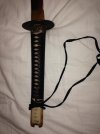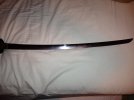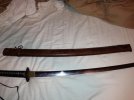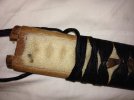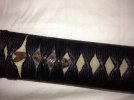- Joined
- Aug 12, 2012
- Messages
- 10
So my dad happened to rediscover today a japanese sword from WWII. As he tells it my great uncle picked it up off the corpse of a japanese officer somewhere in SEA. I'd like to know some more about it. It wears a wood and leather sheath with one ring towards the hilt. There are no markings anywhere on the blade. The hilt is wrapped with a black material. The hilt itself is wood encasing some sort of white fish or eel skin with metallic fish ornaments. There is no pommel. I can provide pictures if necessary.

